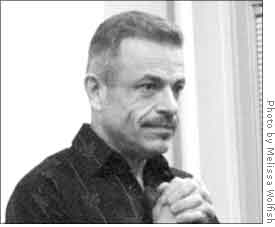
| << Front page | News | March 3, 2006 |
AIDS Brought Close to Home by Alum
 |
||
| Reawakening community: Dr. Bob Frascino, AIDS positive alum, outlines the condition and status of the disease at Oberlin Forum. | ||
When people think of the AIDS epidemic, two instances that come to mind are the United States crisis of the 1980s and the current devastations in Africa. But today, 40 million people throughout the world live with HIV, and everyone must contribute to slow its spread, regardless of where they live.
This is the message that Dr. Bob Frascino, OC ’74, and Dr. Steve Natterstad hoped to convey to their audience of students and community members this past Tuesday at the event “Life. Love. Sex. AIDS, and Other Unscheduled Events.”
Frascino, who is on Oberlin’s Board of Trustees, is the founder of a not-for-profit organization called the Robert James Frascino AIDS Foundation, which recently made a grant contribution to Oberlin. Natterstad is his partner.
Frascino himself has AIDS. In 1991 he was working at his own practice as an HIV specialist and was infected while treating a patient. The patient jerked during a procedure, and the laceration stick Frascino was holding penetrated his glove and hand. Although his chance of retention was 1 in 300, and his initial HIV test was negative, another test came up HIV positive a couple of weeks later, after the disease had had time to develop.
In his presentation Tuesday, Frascino presented a timeline of the changing American face of AIDS, from its first discovery in 1981 to the current response of “complacency, apathy and silence” it provokes in 2006.
He also talked about the AIDS memorial quilt, a panel of which was on display at Oberlin last week.
“I encourage you all to see it whenever you can,” he said. “It’s the most vivid emotional reminder of the HIV/AIDS epidemic.” The quilt, made up of over 45,000 panels, was displayed on the National Mall in Washington D.C. in 1996, near the tail end of what he described as the AIDS’ “activism” era of the mid-1990s.
In the second half of 1996, it was discovered that protease inhibitors greatly slowed down the 10 billion times-a-day viral replication of AIDS. Frascino said that this discovery led to an optimism for AIDS victims that he pegged as “irrational exuberance.”
“We finally found a way to stop the virus from reproducing,” he said. “We all thought that we would be cured if we took these drugs for three years.”
Frascino said the positivity overflowed into the media, including the stories written about his experience.
“I was no longer ‘casualty of war,’” he said. “I was now ‘Bob Frascino: Familiarity brings him into the future.’ I still don’t know what the hell that means.”
Ultimately, the drugs turned out to be ineffective in curing the virus. Natterstad presented a contemporary “report card of AIDS” during his portion of the talk. He examined five aspects of the current state of the disease: diagnosis, treatment, cure, vaccine and prevention.
For treatment and diagnosis he assigned each the grade of B because of recent efforts and developments, although he added that not everyone is able to take new medications because of side effects. For vaccines he assigned a D-, a higher grade than he said it really deserved but given in recognition of invigorated efforts to make a successful vaccine. For cure and prevention he assigned failing grades.
“As of Feb. 28, 2006, not one person has been cured of HIV,” he said. “A cure is really not on the horizon at all.”
Frascino was confident that the fight against AIDS was not too much of a burden for the Oberlin community to take on. His foundation contributed a grant to the Oberlin College and Conservatory of Music AIDS Awareness Program, which he hopes will “reawaken the Oberlin community” to HIV/AIDS awareness and prevention.
“I cannot think of a better focus for Oberlin locally, nationally and
globally,” Frascino said. “I just feel that it has Oberlin stamped
all over it.”
About us
Subscriptions
Advertising